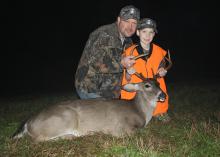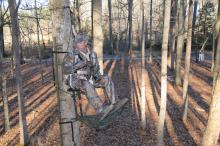Information Possibly Outdated
The information presented on this page was originally released on November 8, 2012. It may not be outdated, but please search our site for more current information. If you plan to quote or reference this information in a publication, please check with the Extension specialist or author before proceeding.
Stay safe when hunting this holiday season
MISSISSIPPI STATE – For many Mississippi families, the holidays are about hunting and eating home-cooked meals, and safety should be as high a priority as sweet potato pie.
“No one wants to spend their holidays in the hospital or at home recovering from an injury, so hunters need to practice common-sense safety precautions,” said Bronson Strickland, a wildlife management specialist with the Mississippi State University Extension Service and associate professor in MSU’s Forest and Wildlife Research Center.
Strickland said the biggest mistake hunters make is not properly securing themselves to their tree stands. All hunters on Wildlife Management Areas must use a fall-arrest system -- a full-body safety harness -- that is manufactured to the Treestand Manufacturers Association standards while climbing a tree, installing a tree stand or hunting from a tree.
“We highly recommend people wear a hunter’s safety harness that secures around the shoulders, waist and legs for three-point security,” Strickland said. “As soon as you approach the tree, go ahead and attach the harness to the tree, because a majority of accidents occur while ascending or descending from a tree stand.
“That way, if you’re climbing up the ladder, you’re 10 feet off the ground and a step breaks, you’re secure,” he said.
The moment the hunter steps over into the stand is also dangerous.
“All of your weight is on one foot, even if it’s just for a millisecond,” Strickland said. “Frost makes the step slick, mud on your boots makes it slippery and sometimes steps break.”
Using a firearm can present a variety of dangers. Strickland said his firearm safety tips are the same ones he has heard since he was a kid.
“Make sure what you’re aiming at is what you want to hit -- identify your target,” he said. “There’s no leeway for guesswork. You have to be 100 percent sure of your target before you pull the trigger.
“With a high-powered rifle, be sure of your surroundings, too. Where will your bullet go if you miss or it goes through your target?” he said.
Dave Godwin, a wildlife biologist with the Mississippi Department of Wildlife, Fisheries and Parks, said safety first is the most basic rule of hunting. Visibility is an important part of safety, and the required orange is visible to other hunters but not to deer.
Hunters are required to wear at least 500 square inches of unbroken fluorescent orange when hunting deer during any primitive weapon or gun season, unless the hunter is completely enclosed in a deer stand.
“Mesh-style or orange camouflage is not considered unbroken and does not count toward the 500 square inch minimum,” Godwin said.
When hunting quail or rabbits on a Wildlife Management Area, hunters must wear a hunter orange vest or hat. Many small game hunters choose to wear orange on private lands even when it is not required by law, Godwin said.
As daylight fades, hunters should use flashlights when leaving the woods, even if they can see clearly.
“The required blaze orange is not visible in low light, but a flashlight or headlamp is,” Strickland said. “You don’t want to be mistaken for an animal by another hunter in the dark.”
Hunting and intoxicating substances do not mix, Godwin cautioned.
“Never consume alcohol or other drugs while hunting or when handling firearms,” he said. “Do not hunt or shoot with anyone who has. Hunting while intoxicated is extremely dangerous to yourself and others. Alcohol affects your body’s mental and physical abilities and impairs your sense of judgment.”
In addition to following proper safety protocols, hunters need to follow the state’s legal requirements.
“You can’t hunt on any street, public road, public highway, levee, right-of-way or railroad. You can’t shoot from your vehicle,” Godwin said.
Before heading to the woods over the holidays, many hunters need to have proof of taking a hunter education course.
“Anyone born after January 1, 1972, must satisfactorily complete a hunter education course approved by the Department of Wildlife, Fisheries and Parks before purchasing a Mississippi hunting license,” Godwin said. “The purpose of the course is to keep hunters safe and prevent accidents and injuries in the woods.”
Youth under age 16 who do not have a hunter education certificate may hunt with a licensed adult, he said.
“Hunting is actually one of the safest outdoor activities that we can enjoy,” Godwin said. “With a little common sense and planning, we can be sure to avoid accidents while making the most of Mississippi’s wildlife resources.”
For information on hunting regulations, Wildlife Management Areas or hunter education courses, visit http://www.mdwfp.com.






